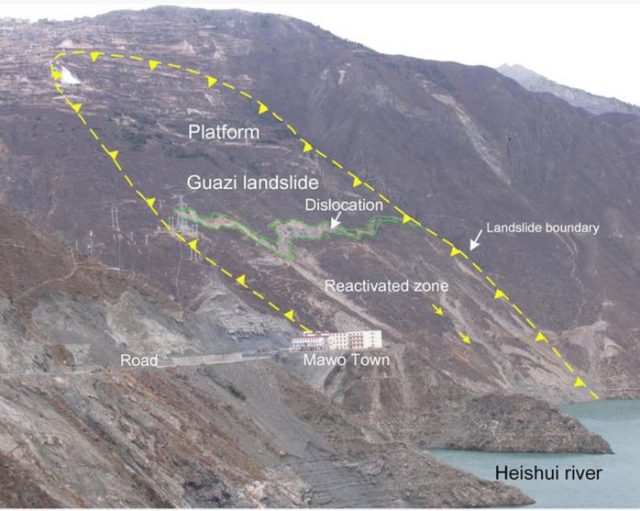7 December 2018
The Guazi landslide: an interesting ancient landslide reactivated by a hydroelectric power scheme in China
Posted by Dave Petley
The Guazi landslide: an interesting ancient landslide reactivated by a hydroelectric power scheme in China
An interesting article in the journal Landslides (Zhao et al. 2018) highlights the Guazi landslide in Heishui County, Sichuan, China. This is a large, ancient landslide located sandstone and phyllite rocks in mountainous terrain on the slopes above the Heishui River. In 2008 a major hydroelectric power scheme was developed downstream of the landslide site, consisting of the Maoergai Dam, a rock-filled embankment dam providing a hydraulic head of about 170 metres, and associated infrastructure. The dam was completed on 20th March 2011, and impoundment of the reservoir was started. On 2nd September 2011, six months after impoundment was initiated, movement of the Guazi landslide was noted.
The current state of the Guazi landslide can be seen in the Google Earth oblique image below:

Google Earth oblique image of the Guazi landslide in Sichuan, China. Image dated October 2015
.
The landslide is about 950 metres from the crown of the ancient slide (marked with the landslide symbol) to the water level, and it is about 550 metres wide. According to Zhao et al. (2018), the ancient landslide has a volume of about 13.5 million m3, with a depth of up to 65 metres. The landslide is marked by tension cracks at the crown, which appeared to widen during the 2008 Wenchuan earthquake. The authors interpret it as a creeping landslide prior to the construction of the dam.
The reactivation in 2011 occurred on the lower slopes, creating a new, very large tension crack. Zhao et al. (2018) provide the following annotated diagram to illustrate both the ancient landslide and the reactivated lower portion. The displacement across the new tension crack is marked as the dislocation zone:-

Annotated photograph of the Guazi landslide in China, from Zhao et al. (2018)
.
Interestingly, I would place the crown of the ancient landslide further upslope than the annotated photograph suggests, but the higher feature may be a secondary slide on the rear scarp. Zhao et al. (2018) note that the landslide reactivated during the first phase of impoundment through to December 2011, primarily in the lower third of the slope. In some places the tension cracks are now 20 metres wide. The slide has been monitored since late 2011; the paper reports that in the period from then to September 2012 some parts of the landslide moved a further 30 cm or so. Measurement using inclinometers suggest that the movement is quite shallow. The upper section of the landslide shows little additional movement.
Zhao et al. (2018) note that at the moment the landslide does not show signs of a larger scale reactivation. But, they note that:
“At present, the Guazi landslide is stable overall; however, confirming its stability in the future is difficult, and long-term monitoring is necessary”
I agree wholeheartedly. In a translational, flexural toppling landslide such as this movement of the toe is likely to be progressively destabilising the system through time. This does not mean that a large-scale reactivation is inevitable, but it cannot be ruled out. And of course this is yet another example of an unanticipated major landslide at a hydroelectric dam project.
Reference
Zhao, B., Wang, Y., Wang, Y. et al. (2018). Triggering mechanism and deformation characteristics of a reactivated ancient landslide, Sichuan Province, China. Landslides https://doi.org/10.1007/s10346-018-1111-0


 Dave Petley is the Vice-Chancellor of the University of Hull in the United Kingdom. His blog provides commentary and analysis of landslide events occurring worldwide, including the landslides themselves, latest research, and conferences and meetings.
Dave Petley is the Vice-Chancellor of the University of Hull in the United Kingdom. His blog provides commentary and analysis of landslide events occurring worldwide, including the landslides themselves, latest research, and conferences and meetings.
Ideal spot for an IBIS-FM…to monitor that slide very well.
Ouch. Should it cut loose, the buildings on that low peninsula are surely in the slosh zone…
Be Not There !!
My money is on reservoir drawdown effects. There is a portion of the peninsula beyond Mawo that is not visible in the Google image.